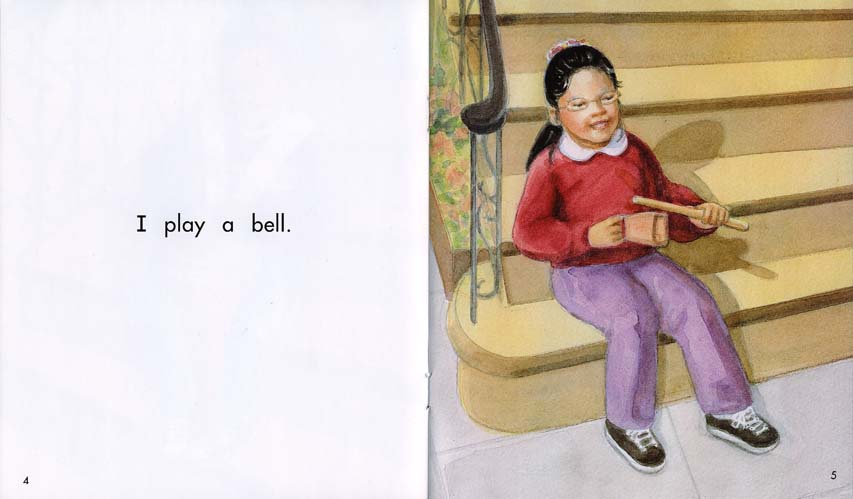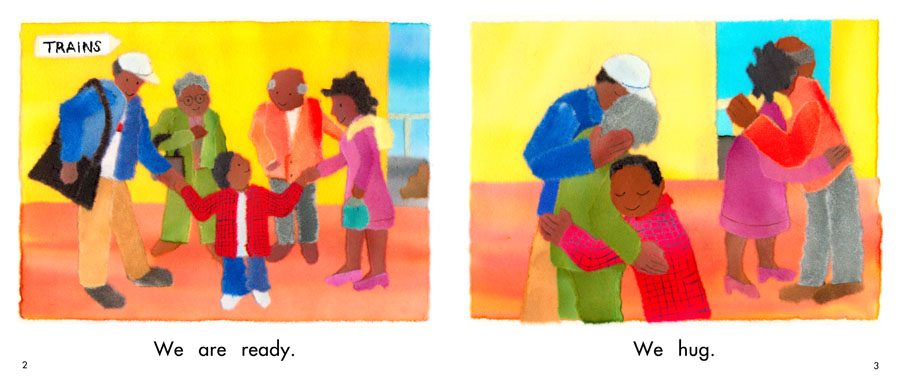In the second post of our Reading Conferences with Beginning Readers blog, our literacy team discusses leveled texts for Kindergarten and what students should learn at levels A through C. This post is taken from our free, downloadable Reading Conferences by Bebop Books guide.
Don’t miss our first post sharing reading conferencing strategies for beginning readers.
Your students are expected to grow from a level A to level C or D by the end of year. But what does that mean?
What makes a book a level A versus a level B? What does a reader at level A need to be able to do? When is a reader ready to move to the next level in kindergarten?
About the Books and Readers at Level A
Books at Level A are designed to assist children in practicing early reading behaviors. The stories are highly predictable. The text is often made up of one-syllable words. Children at this level typically have 12+ books in a plastic bag or bin at a time. An example spread is below from We Play Music:
Conferences to help children with one-to-one matching, moving from left to right across a page, reading the left page before the right page, or checking the pictures for support begin with the teacher asking the child to read the book aloud. Readers at this level should be encouraged to use their finger to track the text as they read.
Readers at level A are working on the following skills and behaviors:
- Moving from left to right across a page
- One-to-one matching
- Using pictures and the text to read
- Reading sight words automatically and accurately
- Retelling/summarizing/synthesizing
- Inferring
About the Books and Readers at Level B
Books at level B are very similar to books at level A and are designed to assist children in early reading behaviors. There are a few differences between level A and level B books. While it is uncommon to find a multisyllable word in the middle of a sentence in a level A book, it may occur in a level B book. Sometimes the text follows a simple pattern, but it is a word at the beginning or in the middle of each sentence that changes. An example spread is below from Train Ride:
To research a child’s ability to retell, summarize, or infer, the teacher should begin by asking one or two questions to engage the child in a conversation about the book. For example, the teacher may ask, “What was this book about?” or “What happened?”
Readers at level B are working on the following skills and behaviors:
- Moving from left to right across a page
- One-to-one matching
- Using pictures and the text to read
- Reading sight words automatically and accurately
- Retelling/summarizing/synthesizing
- Inferring
About the Books and Readers at Level C
Books at level C are designed for children who are beginning to use letter/sound sources of information. The illustrations may provide less text support, and the stories and sentences may be more complex. An example spread is below from What a Street!
When reading books at level C, children must use three sources of information to help them read: meaning, syntax, and visual. When students come across a word they do not know, they need to figure it out by making sure it makes sense, sounds right, and looks right. When conferring with a child, the teacher should coach the child who is stuck on a word to look at the beginning of the word and say a word that makes sense and has the correct first letter.
Readers at level C are working on the following skills and behaviors:
- Using pictures and the text to read
- Reading sight words automatically and accurately
- Using letter(s) of a word (visual) along with meaning and syntax (integrating multiple sources of information)
- Reading fluently upon a rereading
- Retelling/summarizing/synthesizing
- Inferring
These tips and more can be found in our Reading Conferences by Bebop Books Guide.
Interested in ordering Guided Reading books for your kindergarten classroom? Check out our collections of books at levels A, B, and C below:
- Bebop English Guided Reading Level A
- Bebop English Guided Reading Level B
- Bebop English Guided Reading Level C
Get in touch with our team for help creating a customized, diverse Guided Reading collection.
Missed the first post in our Guided Reading in Kindergarten series? Click here to read more.






I found this book a bit disturbing. It is actually good for teaching reading and keeping track of where children are but it is missing some critical information, which would make it most useful.
When benchmarks and reading levels for books are used in the kindergarten, I have encountered teachers who view the child at Level A as somehow being deficient in ability. As a long time early childhood teacher and college professor for over 50 years in NYC, Geneva, Switzerland, and New Jersey, I find this little book disturbing because there is no introductory discussion of child development and average developmental expectations for each age child prior to introducing guided reading.
I just got finished reading an article written by Dr. Nancy Carlsson-Paige about how rushing formal reading to those children who are not developmentally ready for formal instruction in reading sends children a message that they are less capable. And that is what I have seen in kindergarten after kindergarten in many public schools. I think this little book may send teachers into a frenzy, in which they already are, to rush the teaching of formal guided reading.
Read to children a lot. Read good stories that lead to good discussions that even go beyond the actual story content. Discuss the stories with the children. Introduce them to letters and sounds. Talk to them about their lives. Show that that speech can be written down. Observe them and look for signs that they are ready for more, then move forward. Provide them with first-hand experiences that will give them the background information and skills that they need to understand what they will be reading.
Hi Nora,
Thank you so much for reaching out. We completely agree with you that reading to children is essential, and read alouds provide wonderful ways for children to get exposed to and engage with amazing literature. Your points about discussing the stories with children are incredibly important, and we also believe that children need first-hand experiences to obtain background information and skills before reading.
Here at Lee & Low Books, we have an imprint dedicated to culturally responsive and authentic texts for early readers called Bebop Books. We are dedicated to supporting literacy learning content for beginning readers in all kinds of settings— with the same commitment to diversity that sets Lee & Low Books apart. Our titles cover a wide range of concepts, themes, and interest areas that appeal to children.
The purpose of this blog series and Guided Reading document written by Jen Serravallo is to provide teachers suggestions, strategies, and tips on how to engage with early readers when they’re ready to begin to reading independently. We do not believe that children are ever identified by their book’s level, and our intention was not to suggest that teachers should have children reading in kindergarten. Rather, this is a helpful guide for teachers, if they find it useful, to help them when they’re working with students who are embarking on the wonderful journey of reading.
Thank you!
What about the argument that using these Leveled readers is basically the same this as the long discredited whole-word method of teaching reading? Why are the curriculum publishers just repackaging this nonsense and selling it to us again. It doesn’t work. Oh right, because it’s big business. Who cares if the children don’t get solid phonics-based reading instruction. There’s so much money to be made.